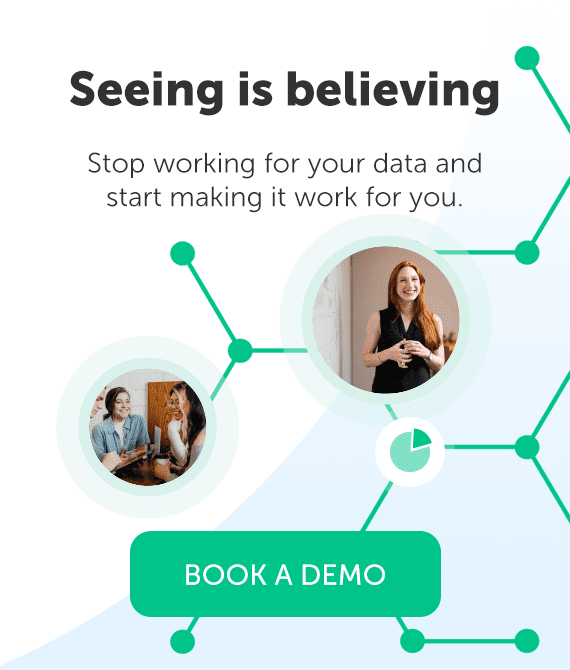A convincing 70% of leading academic economists predict the US will tip into recession in 2023. And since the start of 2022, 10.2 trillion dollars of personal wealth has been shed from the S&P 500.
Given this reality, many firms began early preparations for a recession—from hiring freezes and tech stack consolidation, to layoffs and closer balance sheet analysis. These same companies are implementing cost-saving measures, new strategies, and increasing operational efficiency to ensure survival during this likely recession.
It’s no longer a growth at all costs environment. But while companies are trimming waste and scrutinizing investments, if history tells us anything, we shouldn’t be pressing the pause button on investments entirely. In fact, as we’ve seen in past downturns, by making the right investments, some of the most successful companies have come out of turbulent times stronger than ever.
This brief guide will unpack the business case for incorporating a Customer Intelligence platform into your 2023 budgets and forecasts.
Client data is the fuel that runs the engine that is client relationship management. A deep understanding of your target and existing clients is the foundation of a successful go to market strategy.
Why? Assumptions about clients won’t cut it in any environment, let alone one like we are in, where businesses are operating with more constraints. You need accurate and reliable client data to be the basis of your decision making to find, win, grow and retain your clients with better efficiency and effectiveness. With a strong client data set, you can fuel powerful business intelligence that guides your prospecting efforts, empowers strategic pipeline management, and empowers you to deliver post-sale experiences that drive loyalty, cross-sell, and upsell opportunities with your existing clients.
A System of Record is a Great Start
If someone were to ask you where you would turn to access this data, most would say their Customer Relationship Management system. Afterall, that’s what it was created for, right? To house client data. While that is its intention, the reality of most CRM systems is that they are only as good as the adoption they receive by client facing professionals. They’re entirely dependent on the data entered and maintained by busy professionals who are incentivized and hired to build relationships, win, and deliver work in their areas of expertise, not enter data.
The result is an inaccurate, outdated, and disparate client data set. In fact, we’ve run the numbers: on average, companies are missing 326 contacts per client-facing professional. And the data that’s entered into the system? It decays at a rate of 70% per year! The repercussions of this are felt over and over again throughout the business.
Customer Intelligence – Putting the “R” in CRM
Every single day, client-facing professionals engage with prospects and customers via communication and collaboration systems like Outlook, Gmail, Microsoft Teams and Slack. Each of which produces what we call “digital exhaust”, a trail of communications with external parties. Customer Intelligence taps into these systems to identify, capture, and maintain a complete and accurate record of your firm’s contacts. With Customer Intelligence, firms can enter and navigate times of uncertainty with a complete, up to date, firm-wide understanding of their relationship network.
From System of Record, to System of Intelligence
Achieving and maintaining an accurate and reliable client database is a massive undertaking on its own, but Customer Intelligence goes beyond this foundational data management. Customer Intelligence is the practice of taking this firm wide view of client data and transforming it into relationship insights and actionable intelligence. With access to the volume, recency, and frequency, of communications, Introhive has developed an algorithm to transform your firm’s digital exhaust into powerful insights including the strength of relationships. Customer Intelligence empowers firms to operationalize client data to achieve your most pressing business goals. Let’s explore a few of these key use cases.
Weathering Volatile Market Conditions with Customer Intelligence
Whitespace Analysis
Identifying untapped segments in your client base is one of the best growth levers that firms can use in times of recession where businesses are more conservative in their spending and winning net new business can be more challenging. Tapping into your firm’s existing relationships is one of the best paths to new revenue opportunities, whether it’s a net new sale or a cross-sell or upsell to existing clients. In fact, B2B buyers are five times more likely to meet you via introduction than a cold call, and are shown to close 30% faster.
One of the reasons client retention is so important when faced with economic headwinds, is that existing clients can also be one of your greatest sources of revenue growth. Clients already understand the value your product or service presents to their firm and are likely to increase their investment if it can help them drive revenue, reduce cost, or mitigate risk. After all, they’re looking to grow their business in this challenging environment as well! It’s also easier to sell to existing clients than new ones. In fact, studies show that while you’re between 5-20% likely to sell to a new prospect this increases to between 60-70% when selling to an existing client.
With Introhive’s Whitespace Insights you can easily identify untapped opportunities where established relationships exist. Introhive makes whitespace analysis actionable by revealing relationships with accounts, leads, or contacts providing your best path into net-new or expansion opportunities.
Multithreading
According to Gartner, B2B buying teams have jumped from 6 to 11 members. And in complex, enterprise sales motions, the number of stakeholder on the buy-side can flex up to 20 or more. This means that multithreading your opportunities is more important than ever. As buying groups increase in size, selling tends to increase in complexity.
Establishing a broader and deeper set of ties between the buying and selling team is a signal that you are creating influence in the organization, connecting your solution’s value to the needs of the various stakeholders and their respective goals. This is especially important in times of economic uncertainty as it will increase the likelihood that your solution is worthy of an investment.
Luckily, with Introhive’s Multithreading dashboard you can:
- Pinpoint single threaded opportunities that represent risk
- Identify existing relationships that can help you multithread
- Visualize the buying group to ensure you are engaging with an appropriate depth and breadth at the account or opportunity
By the way, multithreading opportunities isn’t just a pre-sale best practice! It’s equally, if not more important to ensure you’re maintaining engagement and influence post-sale as well so you can grow and retain those accounts that you worked so hard for. Multithreading also leads to a more seamless succession planning process, where a web of existing stakeholders can be relied upon to backfill departing employees.
Lonely Client Reporting
Client centricity is a practice that more and more firms are striving to adopt and maintain, and one that Customer Intelligence enables. Regardless of the times we’re in, you need to ensure you’re maintaining proper engagement levels with your clients, but now and into 2023, every customer is evaluating their expenditures to determine which vendors are worthy of continued investment. If 5% more customer retention means 25-95% more revenue, every organization needs a rock-solid strategy when it comes to maintaining engagement levels with customers- and in times of economic pressure such as the environment we’re in today, where businesses are inspecting their investments to see where they can trim costs you can’t afford for client retention to be an afterthought.
Many firms employ a subjective “Red, Yellow, Green” account health strategy. With Introhive’s Lonely Client Analysis firms can transform account management into a data driven practice by layering relationship trends against last interaction dates to ensure proper coverage is maintained across their client base and employing an objective view into client health.
Using Lonely Client Analysis dashboards, you can pinpoint and maintain relationships that are strong, and invest further in those that may not be getting their fair share of attention. This is one of many ways Customer Intelligent firms are relying on leading indicators to maintain client experience and mitigate churn.
As you evaluate where you want to invest for growth in 2023, we welcome the opportunity to share more about how Introhive’s Customer Intelligence platform can empower you to do more with less in order to achieve new levels of both efficiency, and effectiveness. If you’re looking to not just survive, but thrive in times of disruption, Customer Intelligence may be exactly what you’re looking for.





